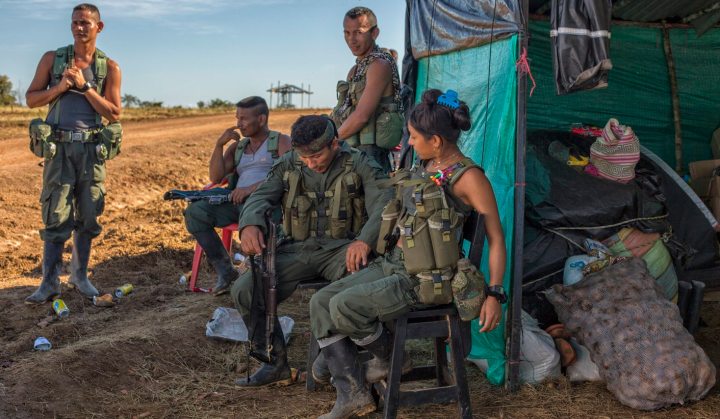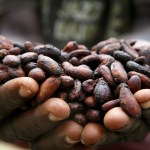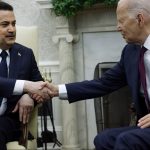World
The Country that Voted Against Peace: The reasons behind Colombia’s failed negotiation

The peace process between the Colombian government and FARC Marxist guerrillas has been a fiery topic in Colombia since September 26, when a final agreement was signed between both parts in Havana, and the decision to ratify or reject it was passed over to voters in a plebiscite which took place on Sunday, October 2. By SANTIAGO VILLA.
“It’s forbidden to talk about peace in this house,” my aunt warned me when I arrived at her home on Friday for one of the weekly extended-family get-togethers she arranges. The topic was banned because my father and my uncle had engaged in a heated argument which ended in a raucous falling-out. Since then my uncle would not take my father’s phone calls.
Peace, or more specifically, the peace process between the Colombian government and FARC Marxist guerrillas, has been a fiery topic in Colombia since September 26, when a final agreement was signed between both parts in Havana, and the decision to ratify or reject it was passed over to voters in a plebiscite which took place on Sunday, October 2.
Its only question was: “Do you support the final accord to end the armed conflict and build a stable, lasting peace?”
Although the latest voting poll commissioned by Colombian mainstream media, and published during the first week of September, said 59% of voters supported the accords, 33% didn’t, and 5% were indecisive, there has been an intense campaign against the agreement, led by figures as influential as Colombia’s two former presidents, the Procurator General, a former mayor of Bogotá, one of the two main news channels, and a swarm of right-wing political pundits.
The final voting count was nerve-wracking.
An hour-and-a-half after the voting tables closed, with 83% of the votes counted, 5,235,000 were for YES, and 5,234,000 for NO.
The tables turned after 95% of the vote count was in. The final result was 6,431,000 for NO and 6,377,000 for YES. A difference of about 55,000 votes amongst nearly 13-million ballots. The end result has been a step towards uncertainty, which can lead to the reigniting of a 52-year long armed conflict.
Why did the country vote against peace?
From guerrillas to narcoterrorists
It’s difficult to underestimate resentment against the Colombian Revolutionary Armed Forces (FARC). Loathing against FARC became bitterly acute after the previous peace process (1998-2002) failed, because it was widely seen as manipulated by the guerrillas to strengthen their more than 15,000-strong army, while they enjoyed the benefits of a demilitarised zone the size of Switzerland, where they even held civilians previously kidnapped for ransom.
Likewise, FARC accuse the Colombian government of having used the previous peace process as a ruse to achieve a military build-up of their own, backed by the United States and paramilitary death squads. After four years of conversations with no negotiating agenda, frustration with FARC prompted the two-term election of far right-wing candidate Alvaro Uribe Vélez (2002-2010), whose father was allegedly murdered by FARC in 1983 during a failed kidnapping attempt – a charge the FARC have repeatedly denied – and Colombia entered a state of total war.
A string of hard blows, and even war crimes, eroded the Marxist guerrillas’ image and credibility. An elite social club in Bogotá was bombed in 2003 by FARC, killing 36 people. In 2007, 11 members of the Valle del Cauca provincial assembly, who had been kidnapped and held for five years, were murdered in cold blood. And they were also responsible for perhaps the most internationally reported kidnapping in the 21st century, that of presidential candidate Ingrid Betancourt. Hers was merely one in more than 10,500 kidnappings committed by FARC between 1985 and 2014, many of them after 2000, the year when FARC leaders gave a command they named “Law 002”, which urged all guerrilla fronts to collect money through kidnapping ransoms.
This pushed many landowners and businessmen in Colombia to finance paramilitary groups, and war became even bloodier. Through kidnapping, FARC collected $1.76-billion in ransoms, although most of their revenue still came from drug production and trafficking. Former president Uribe insisted in not calling them “guerrillas”, but “narcoterrorists”.
The largest public march in Colombian history was sparked by a Facebook meme in 2008. It read: “No more kidnappings, no more lies, no more murders, no more FARC. One million voices against FARC on February 4th”. About six-million people in the country’s major cities took to the streets.
The defence minister at that time was the then war-trumpeting Juan Manuel Santos. “The FARC used to live like kings, now they live like rats,” he proudly declared in 2009, after three years of heading an intense military offensive that for the first time targeted the clandestine camps of guerrilla commanders, thanks to state of the art “smart bombs” supplied by the CIA.
Under the banner of maintaining a strong offensive against FARC and giving continuity to Uribe’s policy, Santos won the 2010 presidential elections. Although Santos received his former boss’s open support with a fervour that several times defied Colombian law, which bans active presidents from participating in electoral politics, early on into his presidency it became clear Santos would run his own show. This caused an abysmal rift between Uribe and Santos which was at the heart of Sunday’s election results.
The first sign Santos would take a different path from his predecessor was declaring president Hugo Chavez his “new best friend”, a few weeks after being sworn into office. Chavez, whom Santos previously, while defence minister, had repeatedly accused of harbouring FARC guerrillas in Venezuela (this was the reason for a break in diplomatic relations between both countries), had become the main international political opponent of Uribe.
Although at the time rumour had it Santos was seeking Chavez’s support for future peace negotiations with FARC guerrillas, the military drive he maintained suggested otherwise. During the first couple of years of his presidency, military commandos and bombings killed Alfonso Cano and Jorge Briceño, the first and second in command of FARC. The offensive seemed in full swing. The guerrillas were weaker than ever.
Then, in October 2012, Santos surprisingly revealed that his brother, journalist Enrique Santos, and Sergio Jaramillo, an Oxford philologist and Cambridge philosopher who specialised in diplomacy for peace and defence studies, and who was Santos’s vice-minister of defence, had conducted secret contacts for months in Havana with FARC’s new leader, Timoleón Jiménez.
The opening of peace negotiations was immediately denounced by Alvaro Uribe as betrayal. Uribe, who still has wide popular support in Colombia, and was elected senator in 2014, imbued the peace process with his personal animosity and constant criticism. Santos, in an attempt to assuage political opposition, announced that the final peace accords would be submitted to a national plebiscite.
On October 2, after a low turnout, 50.2% of voters decided against Santos. Santos now expects renegotiation of the deal. That, however, could be more complicated than what it seems.
The failed accords
Ban Ki-moon, the United Nations Secretary-General, John Kerry, the US Secretary of State, Borge Brende, the Norwegian Foreign Minister, Juan Carlos I, the former king of Spain, and dozens of heads of state were moved almost to tears by a rendering of Beethoven’s Ode to Joy, played after Juan Manuel Santos, president of Colombia, and Timoleón Jiménez signed the peace accords with a pen made of bullets, during a ceremony in Cartagena, the Caribbean colonial city and the country’s most popular tourist destination.
“What’s written on paper will become reality, and for this to be possible, besides international verification, we need the Colombian people to be the main guarantors of this pact,” said Jiménez during his speech. Less than a week later, a slim majority of Colombian voters rejected it, expecting a better deal.
The government’s negotiating team was composed of high-profile political leaders, but not professional politicians. Sergio Jaramillo made the initial contacts with FARC and is today the High Commissioner for Peace. Humberto de la Calle, the team’s leader, had been in 1992 the government representative during failed peace negotiations with several guerrilla groups, FARC among them. Frank Pearl used to be the High Commissioner for Peace during Álvaro Uribe’s presidency. Luis Carlos Villegas was the director of the National Association of Industry Owners. General Oscar Naranjo was head of police for five years. And Jorge Enrique Mora was head of the military for four years.
The FARC negotiating team was headed by Iván Márquez, a former politician of Union Patriótica, a left-wing party whose members were killed in the 1980s by paramilitary death squads allied with forces within the Colombian state; Fabián Ramírez and Pastor Alape, for whom the Colombian and United States government have offered ransoms of $2-million; Pablo Catatumbo and Andrés París, who have participated in two previous failed negotiations between FARC and the Colombian government; Rodrigo Granda, who was captured in Venezuela by Colombian secret agents in 2004, and smuggled into Colombia through a covert operation ordered by Alvaro Uribe, although a couple of years later he was released as part of a prisoner exchange; Marco Calarcá, one of the guerrillas’ main political advisors, and Jesus Santrich, who became blind because of Leber optic atrophy, and directed the guerrillas’ clandestine radio stations.
Strict rules were set for four years of negotiations in Havana: they would unfold behind closed doors without a bilateral ceasefire, and nothing would be considered as agreed upon until all of the accords were accepted by both parties.
The 297 pages of the final accords are not easy reading. They have 23 points about six topics: agriculture, drug policy, victims, political participation, transitional justice, and the implementation of the accords themselves. Every point discomfited a segment of Colombia’s voters. The agricultural accords promoted rural reforms that scared large landowners. The drug policy accords were criticised for paving the way for the decriminalisation and promotion of coca plant growing. Reparation of victims was thought insufficient, when compared to the fortunes amassed by FARC and its leaders through drug trafficking, extortion and kidnapping.
But the most contentious points were political and judicial advantages to guerrilla leaders. Five seats in both houses of Congress would be given for 10 years to the political party created by FARC. For a decade they would also receive special voting privileges in their areas of influence and state funding. Likewise, a sentence of five to eight years would be imposed for the worst crimes when confessed to a transitional justice tribunal. They could be served in special places created for the FARC, and not regular prisons. For regular crimes, the sentence could be as low as two years, or there could be amnesty.
Finally, as part of the implementation of the accords, roughly $200 would be given to every guerrilla member for two years, while the former combatants found jobs. Many working class Colombians, who earn little more than that every month, considered this a reward to criminality.
This was too big a pill to swallow for 50.2% of the voter turnout, which was still a mere 37% of registered voters. All in all, the peace process fell flat because of 18.4% of the voting census casting a ballot against it. The main protagonist of Sunday’s election was clearly absenteeism, perhaps even indifference.
But opposition to the accords also surfaced because of situations which had nothing to do with the 297-page text itself (which, by the way, most of the people I’ve spoken to didn’t read). Perhaps the most telling example of how a confusing political context influenced the results is the loud scandal surrounding a programme of the Ministry of Education, aimed against discrimination and bullying in Colombian schools.
A couple of months before the elections, a draft of educational guides against discrimination, written by Unicef and the Ministry of Education, was leaked. Its open tolerance towards homosexuality was denounced by Evangelical Christian groups – an increasingly influential political force in Colombia. Former congresswoman Gina Parody, who was the minister of education and is openly gay, was accused of trying to further an agenda of “gender ideology” which would “sexually corrupt children”. Evangelical leaders, from then on, campaigned against the peace accords with FARC, which they insisted promoted homosexuality and “sexual deviancy”. As a show of support to Parody, but defiance against an influential social group, president Santos urged her to interrupt her work in the ministry to lead the campaign for the peace accords. Gina Parody resigned the day after the accords were voted against.
And now what?
Juan Manuel Santos and Timoleón Jiménez, who were among the most likely winners of the 2016 Nobel Peace Prize, have been scrapped off the list. “Colombia’s off any credible list,” said Kristian Berg Harpviken, the head of the Peace Research Institute in Oslo.
But this is the least of Colombian people’s worries. In the country, a surreal mix of dismay, optimism, confusion, and mostly uncertainty, prevails.
The FARC have said they will not renegotiate the accords because they can be implemented, irrespective of the plebiscite’s result. This may be judicially true, but politically impossible. The main opposition party, headed by Alvaro Uribe, has said they will not join the current government in any new deal with FARC, which effectively paralyses the process since any advance cannot be done without them.
As for now, president Juan Manuel Santos has stated that the ceasefire will end on October 31. To this, Jiménez commented in Twitter: “And after that what, war again?”
The countdown has began, and there is little more than four weeks to salvage a process in which the different parts are strengthening their positions for hardball.
Optimistic observers say this is the best possible outcome because a “negotiation anchor” has been set, and the accords can be improved if the FARC’s interest in peace is genuine. According to them, FARC leaders will have to understand Colombian people expect less leniency. Their message to FARC is: comply or return to the bush.
In the meantime, FARC leaders have ordered their troops to return to “safe positions to avoid provocations”. Although all parts have said they want peace, at this point there are no accords or a clear path forward. War seems an equally probable scenario.
Presidential elections will take place in 2018, so opposition parties will be tempted to dilate any resolution and use uncertainty to their advantage. Their incentive is the political triumph of sealing negotiations under their leadership. Uribe, always a hardliner when it comes to FARC, is politically stronger when animosity against the guerrilla is stronger. Right now, he’s in a win-win situation, with little incentive to move forward swiftly.
In the meanwhile, the clearest chance for peace that Colombia has had in half a century is slipping away. DM
Photo of FARC soldiers by Salym Fayad.
















 Become an Insider
Become an Insider